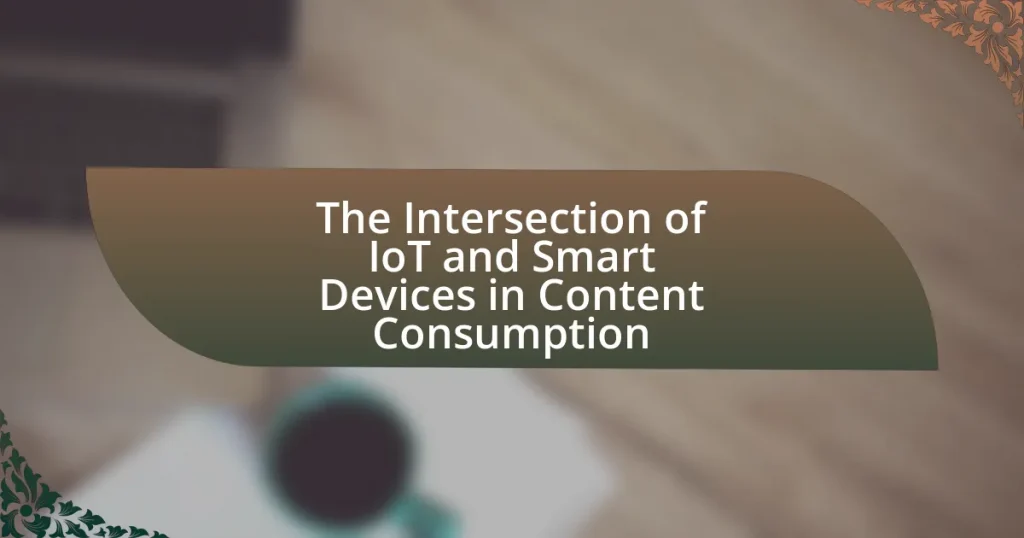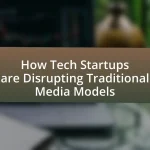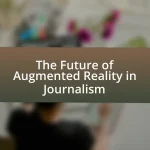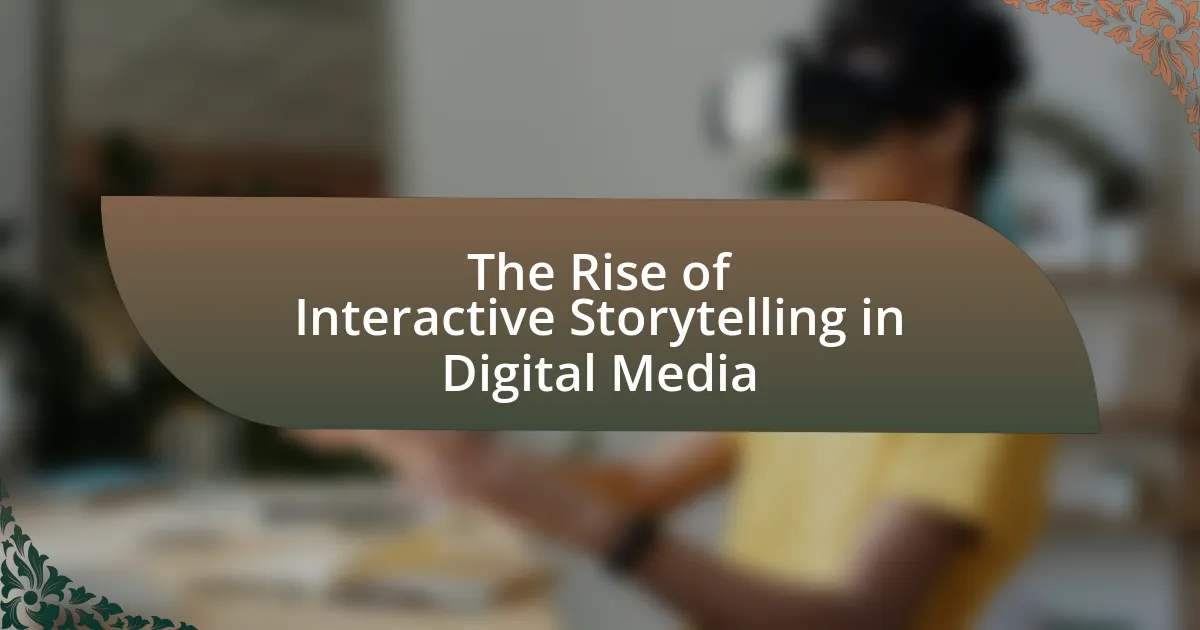The article focuses on the intersection of the Internet of Things (IoT) and smart devices in content consumption, highlighting how interconnected devices enhance user access and interaction with digital media. It discusses the contributions of IoT and smart devices, including seamless access, personalization, and real-time data processing, which collectively improve user engagement. Key challenges such as data privacy, interoperability, and security concerns are also examined, alongside the future implications of advancements like 5G technology and artificial intelligence. The article emphasizes best practices for consumers to optimize their experiences while ensuring security and privacy in their content consumption activities.
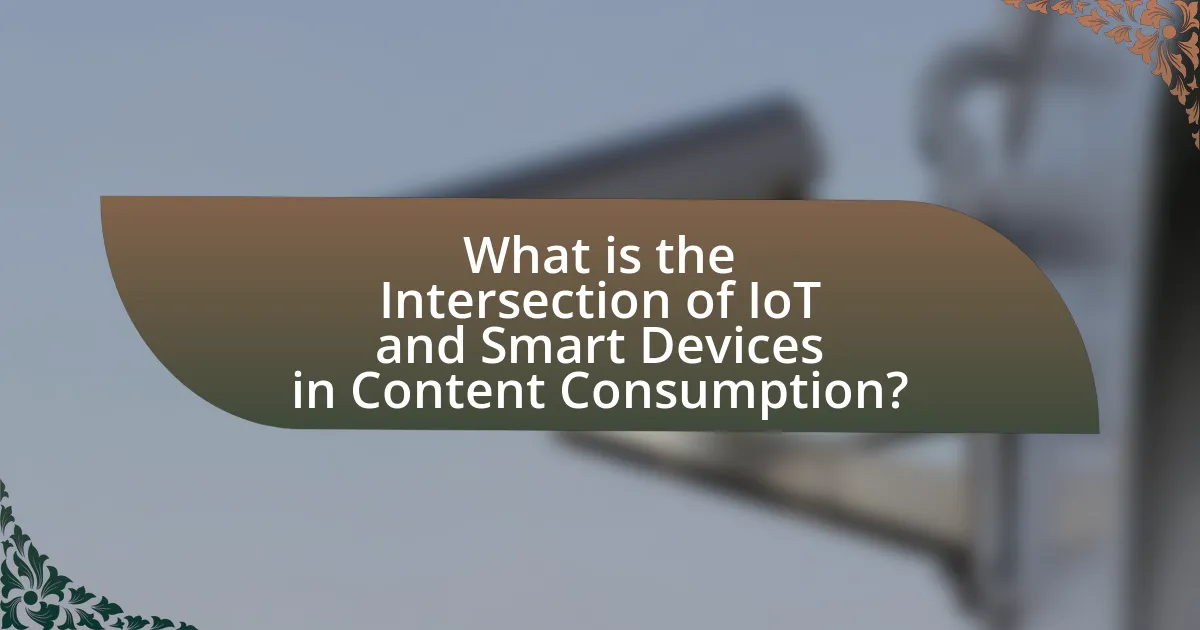
What is the Intersection of IoT and Smart Devices in Content Consumption?
The intersection of IoT and smart devices in content consumption refers to the integration of interconnected devices that enhance the way users access and interact with digital content. IoT devices, such as smart TVs, voice assistants, and connected home systems, facilitate seamless content delivery and personalized experiences by collecting and analyzing user data. For instance, a smart TV can recommend shows based on viewing habits, while voice assistants can provide content through voice commands, demonstrating how these technologies work together to optimize user engagement and convenience in content consumption.
How do IoT and smart devices contribute to content consumption?
IoT and smart devices enhance content consumption by providing seamless access to digital media across various platforms. These devices, such as smart TVs, smartphones, and wearables, enable users to stream, download, and interact with content anytime and anywhere. According to a report by Statista, the number of connected devices worldwide is projected to reach 30.9 billion by 2025, indicating a significant increase in potential content consumption avenues. Furthermore, IoT devices collect user data to personalize content recommendations, improving user engagement and satisfaction. This integration of technology not only facilitates easier access but also tailors the content experience to individual preferences, thereby driving higher consumption rates.
What are the key features of IoT that enhance content consumption?
The key features of IoT that enhance content consumption include connectivity, personalization, and real-time data processing. Connectivity allows devices to communicate seamlessly, enabling users to access content across multiple platforms and devices. Personalization leverages user data to tailor content recommendations, improving user engagement and satisfaction. Real-time data processing facilitates immediate updates and interactions, ensuring that users receive the most relevant content at the right moment. These features collectively create a more integrated and user-centric content consumption experience, as evidenced by the increasing adoption of smart devices that utilize IoT technology to deliver customized content efficiently.
How do smart devices facilitate access to content?
Smart devices facilitate access to content by providing seamless connectivity and user-friendly interfaces that enable instant retrieval of information and media. These devices, such as smartphones, tablets, and smart TVs, utilize internet connectivity to access a vast array of online content, including streaming services, social media, and news platforms. For instance, according to a report by Statista, as of 2023, over 80% of households in the United States own at least one smart device, highlighting their prevalence and the ease with which users can access diverse content. Additionally, smart devices often incorporate voice recognition and artificial intelligence, allowing users to search for and interact with content using natural language, further enhancing accessibility.
Why is the intersection of IoT and smart devices important for consumers?
The intersection of IoT and smart devices is important for consumers because it enhances convenience, efficiency, and personalization in daily life. IoT enables smart devices to communicate and share data, allowing consumers to automate tasks, monitor their environments, and receive tailored content and services. For instance, a study by Statista indicates that the global number of connected IoT devices is expected to reach 30.9 billion by 2025, illustrating the growing integration of these technologies in consumer lifestyles. This connectivity leads to improved user experiences, such as smart home systems that optimize energy use and security, ultimately providing consumers with greater control and satisfaction in their interactions with technology.
What advantages do consumers gain from this intersection?
Consumers gain enhanced convenience and personalized experiences from the intersection of IoT and smart devices in content consumption. This integration allows for seamless access to content across multiple devices, enabling users to consume media anytime and anywhere. For instance, smart TVs, smartphones, and tablets can synchronize viewing preferences and history, tailoring recommendations based on individual tastes. According to a report by Statista, 70% of consumers prefer personalized content, highlighting the demand for such tailored experiences. Additionally, IoT devices can automate content delivery, allowing consumers to receive updates and notifications about new releases or relevant content without manual searches, further streamlining the consumption process.
How does this intersection influence consumer behavior?
The intersection of IoT and smart devices significantly influences consumer behavior by enhancing personalization and convenience in content consumption. This integration allows consumers to receive tailored content recommendations based on their preferences and usage patterns, leading to increased engagement. For instance, a study by Deloitte in 2021 found that 80% of consumers prefer personalized experiences, which are facilitated by IoT-enabled devices that track user interactions. Additionally, smart devices streamline access to content, enabling consumers to engage with media seamlessly across multiple platforms, thereby increasing the frequency and duration of content consumption.
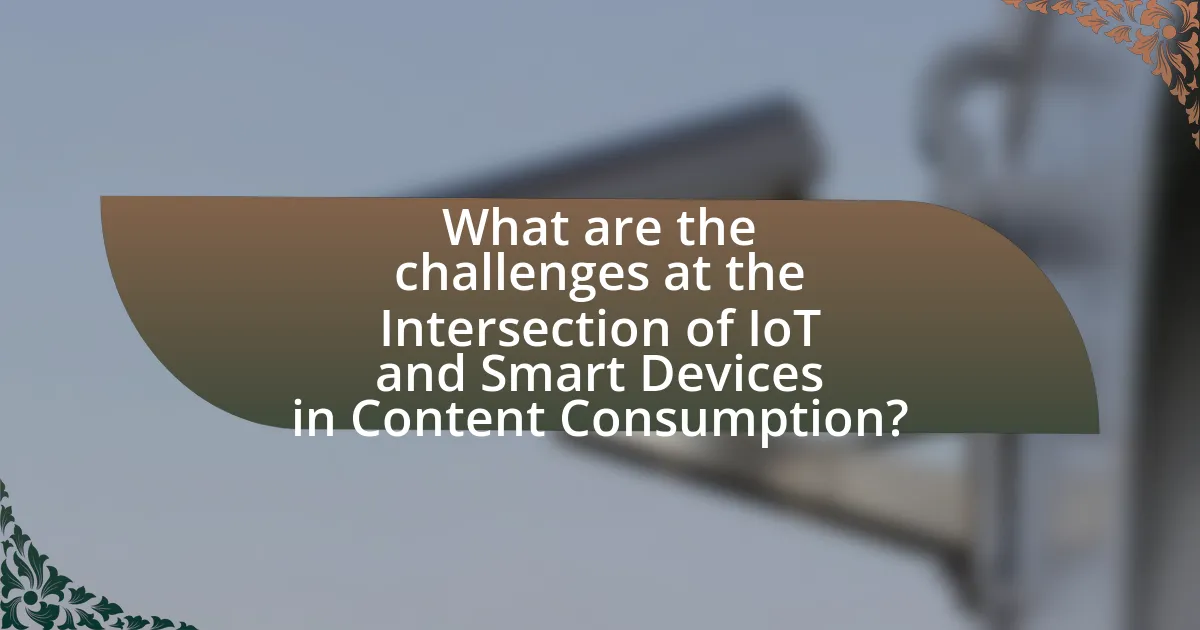
What are the challenges at the Intersection of IoT and Smart Devices in Content Consumption?
The challenges at the intersection of IoT and smart devices in content consumption include data privacy, interoperability, and user experience. Data privacy concerns arise as smart devices collect vast amounts of personal information, leading to potential misuse or breaches. Interoperability issues occur when different devices and platforms fail to communicate effectively, hindering seamless content access. User experience can be compromised due to varying device capabilities and inconsistent content delivery, which can frustrate users. These challenges are critical as they impact the overall effectiveness and acceptance of IoT and smart devices in enhancing content consumption.
What security concerns arise from IoT and smart devices in content consumption?
Security concerns arising from IoT and smart devices in content consumption include data privacy breaches, unauthorized access, and device vulnerabilities. These devices often collect sensitive user data, which can be exploited if not properly secured. For instance, a study by the Ponemon Institute found that 57% of organizations experienced a data breach due to insecure IoT devices, highlighting the risks associated with inadequate security measures. Additionally, many smart devices lack robust authentication protocols, making them susceptible to hacking and unauthorized control, which can lead to further exploitation of personal information.
How can data privacy be maintained in this context?
Data privacy can be maintained in the context of IoT and smart devices in content consumption by implementing robust encryption protocols and strict access controls. Encryption protects data during transmission and storage, ensuring that unauthorized parties cannot access sensitive information. For instance, the use of Advanced Encryption Standard (AES) can secure data, as it is widely recognized for its effectiveness in safeguarding digital information. Additionally, employing access controls, such as multi-factor authentication, limits data access to authorized users only, thereby reducing the risk of data breaches. According to a report by the Internet of Things Security Foundation, implementing these measures can significantly enhance the security posture of IoT devices, ensuring that user data remains private and secure.
What measures can be taken to protect users from cyber threats?
To protect users from cyber threats, implementing strong security protocols is essential. This includes using robust passwords, enabling two-factor authentication, and regularly updating software to patch vulnerabilities. According to a 2021 report by Cybersecurity Ventures, cybercrime is projected to cost the world $10.5 trillion annually by 2025, highlighting the urgency of these protective measures. Additionally, educating users about phishing attacks and safe browsing practices can significantly reduce the risk of falling victim to cyber threats.
What technical limitations exist in the integration of IoT and smart devices?
The technical limitations in the integration of IoT and smart devices include issues related to interoperability, security vulnerabilities, and bandwidth constraints. Interoperability challenges arise because various devices often use different communication protocols, making seamless integration difficult. Security vulnerabilities are prevalent due to the increased number of connected devices, which can be exploited by cyberattacks; for instance, a report by the Internet of Things Security Foundation highlights that 70% of IoT devices are susceptible to attacks. Bandwidth constraints can hinder performance, as the growing number of connected devices can lead to network congestion, impacting data transmission speeds and reliability.
How do connectivity issues affect content consumption?
Connectivity issues significantly hinder content consumption by causing interruptions, buffering, and reduced quality of streaming services. When users experience slow or unstable internet connections, they often face delays in loading content, which can lead to frustration and decreased engagement. According to a report by Akamai, a 1-second delay in page load time can lead to a 7% reduction in conversions, highlighting the impact of connectivity on user experience. Furthermore, studies show that 53% of mobile users abandon sites that take longer than three seconds to load, emphasizing the critical role of reliable connectivity in maintaining viewer attention and satisfaction.
What role does bandwidth play in the effectiveness of smart devices?
Bandwidth is crucial for the effectiveness of smart devices as it determines the speed and volume of data that can be transmitted over a network. High bandwidth allows smart devices to communicate efficiently, enabling real-time data processing and seamless interaction with other devices and services. For instance, a study by Cisco indicates that increased bandwidth can enhance the performance of IoT applications, leading to faster response times and improved user experiences. This is particularly important in content consumption scenarios, where devices like smart TVs and streaming services require substantial data transfer to deliver high-quality video and audio without buffering.
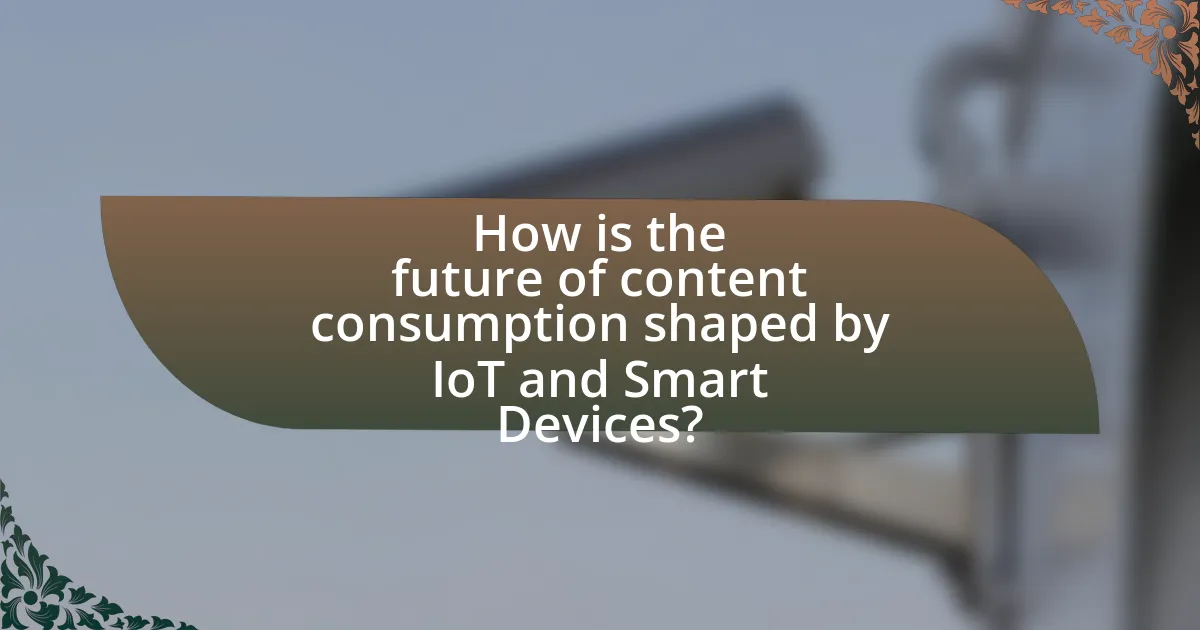
How is the future of content consumption shaped by IoT and Smart Devices?
The future of content consumption is significantly shaped by IoT and smart devices through enhanced personalization and seamless integration. IoT devices, such as smart TVs, wearables, and home assistants, collect user data to tailor content recommendations, improving user engagement. For instance, a report by Statista indicates that the number of connected IoT devices is expected to reach 75 billion by 2025, facilitating a more interconnected ecosystem for content delivery. This connectivity allows for real-time content updates and interactions, enabling users to consume media across multiple platforms effortlessly. Additionally, smart devices enhance accessibility, allowing users to access content anytime and anywhere, which further drives consumption patterns.
What emerging trends are influencing the intersection of IoT and smart devices?
Emerging trends influencing the intersection of IoT and smart devices include increased integration of artificial intelligence, enhanced data security measures, and the rise of edge computing. The integration of artificial intelligence allows smart devices to learn user preferences and optimize functionality, leading to more personalized experiences. Enhanced data security measures are becoming critical as the number of connected devices grows, with a focus on protecting user data from breaches. Edge computing reduces latency by processing data closer to the source, improving the responsiveness of smart devices. According to a report by Gartner, by 2025, 75% of enterprise-generated data will be created and processed outside the centralized data center, highlighting the shift towards edge computing in IoT applications.
How are advancements in AI impacting content consumption through smart devices?
Advancements in AI are significantly enhancing content consumption through smart devices by personalizing user experiences and optimizing content delivery. AI algorithms analyze user behavior, preferences, and engagement patterns, allowing smart devices to recommend tailored content that aligns with individual interests. For instance, streaming services like Netflix utilize AI to suggest shows and movies based on viewing history, resulting in increased user satisfaction and engagement. Additionally, AI-driven voice assistants, such as Amazon’s Alexa, facilitate hands-free content access, making it easier for users to consume information and entertainment seamlessly. These advancements lead to more efficient content discovery and consumption, ultimately transforming how users interact with digital media on smart devices.
What role will 5G technology play in enhancing IoT and smart device capabilities?
5G technology will significantly enhance IoT and smart device capabilities by providing faster data transfer speeds, lower latency, and increased connectivity. This advancement allows for real-time communication between devices, enabling seamless integration and operation of smart systems. For instance, 5G can support up to one million devices per square kilometer, facilitating the deployment of smart cities and connected environments. Additionally, the reduced latency of 1 millisecond compared to 4G’s 30-50 milliseconds enables applications like autonomous vehicles and remote healthcare services to function effectively, showcasing the transformative impact of 5G on IoT and smart devices.
What best practices should consumers follow when using IoT and smart devices for content consumption?
Consumers should prioritize security and privacy when using IoT and smart devices for content consumption. This includes regularly updating device firmware to protect against vulnerabilities, using strong, unique passwords for device accounts, and enabling two-factor authentication where available. According to a 2021 report by the Cybersecurity & Infrastructure Security Agency, 85% of IoT device breaches occur due to weak passwords, highlighting the importance of robust security measures. Additionally, consumers should be mindful of the data they share with these devices, as many collect personal information that can be exploited if not properly managed. By following these best practices, consumers can enhance their safety and privacy while enjoying content through IoT and smart devices.
How can users optimize their smart devices for better content experiences?
Users can optimize their smart devices for better content experiences by ensuring that their devices are updated with the latest software and firmware. Regular updates enhance performance, security, and compatibility with new content formats. Additionally, users should adjust their device settings, such as display resolution and audio output, to match the content being consumed, which can significantly improve the viewing or listening experience. For instance, streaming services often recommend specific settings for optimal playback quality. Furthermore, users can manage their network connections by using high-speed internet and minimizing interference, as a stable connection is crucial for seamless content streaming. According to a study by the Pew Research Center, 73% of users reported improved satisfaction with content consumption when their devices were properly configured and connected.
What tips can help ensure a secure and enjoyable content consumption experience?
To ensure a secure and enjoyable content consumption experience, users should prioritize using strong, unique passwords for their accounts and enable two-factor authentication whenever possible. Strong passwords significantly reduce the risk of unauthorized access, as studies show that 81% of data breaches are linked to weak or stolen passwords. Additionally, keeping software and devices updated protects against vulnerabilities that could be exploited by malicious actors. Regularly reviewing privacy settings on streaming platforms and smart devices also enhances security by limiting data sharing. Furthermore, utilizing a reputable VPN can safeguard online activity from potential eavesdropping, especially on public Wi-Fi networks. These practices collectively contribute to a safer and more enjoyable content consumption experience.
